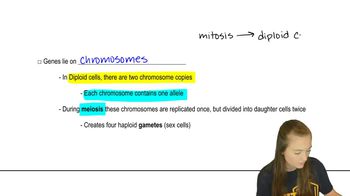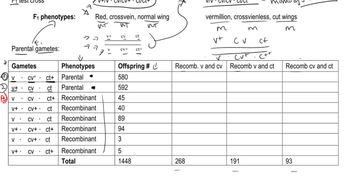Table of contents
- 1. Introduction to Genetics51m
- 2. Mendel's Laws of Inheritance3h 37m
- 3. Extensions to Mendelian Inheritance2h 41m
- 4. Genetic Mapping and Linkage2h 28m
- 5. Genetics of Bacteria and Viruses1h 21m
- 6. Chromosomal Variation1h 48m
- 7. DNA and Chromosome Structure56m
- 8. DNA Replication1h 10m
- 9. Mitosis and Meiosis1h 34m
- 10. Transcription1h 0m
- 11. Translation58m
- 12. Gene Regulation in Prokaryotes1h 19m
- 13. Gene Regulation in Eukaryotes44m
- 14. Genetic Control of Development44m
- 15. Genomes and Genomics1h 50m
- 16. Transposable Elements47m
- 17. Mutation, Repair, and Recombination1h 6m
- 18. Molecular Genetic Tools19m
- 19. Cancer Genetics29m
- 20. Quantitative Genetics1h 26m
- 21. Population Genetics50m
- 22. Evolutionary Genetics29m
4. Genetic Mapping and Linkage
Trihybrid Cross
Problem 45a
Textbook Question
Domestic dogs evolved from ancestral gray wolves. Wolves have coats of short, straight hair and lack 'furnishings,' a growth pattern marked by eyebrows and a mustache found in some domestic dogs. In domestic dogs, coat variation is controlled by allelic variation in three genes. Recessive mutant alleles in the FGF5 gene result in long hair, while dogs carrying the dominant ancestral allele have short hair. Likewise, recessive mutant alleles in the KRT71 gene result in curly hair, whereas dogs with an ancestral dominant allele have straight hair. Dominant mutant alleles in the RSPO2 gene cause the presence of furnishings, while dogs homozygous for the ancestral recessive allele have no furnishings. A pure-breeding curly- and long-haired poodle with furnishings was crossed to a pure-breeding short- and straight-haired border collie lacking furnishings
If dogs of the F₁ generation are interbred, what proportions of genotypes and phenotypes are expected in the F₂?
 Verified step by step guidance
Verified step by step guidance1
Identify the genotypes of the parent dogs. The poodle is homozygous recessive for FGF5 (long hair) and KRT71 (curly hair) and homozygous dominant for RSPO2 (furnishings). The border collie is homozygous dominant for FGF5 (short hair) and KRT71 (straight hair) and homozygous recessive for RSPO2 (no furnishings).
Determine the F₁ generation genotypes. Since the poodle and border collie are pure-breeding, the F₁ offspring will be heterozygous for all three genes: FGF5 (short hair), KRT71 (straight hair), and RSPO2 (furnishings).
Set up a Punnett square for the F₂ generation. Since the F₁ generation is heterozygous for all three genes, use a 4x4 Punnett square for each gene to determine the possible genotypes of the F₂ generation.
Calculate the phenotypic ratios for the F₂ generation. Consider each gene separately: FGF5 (short vs. long hair), KRT71 (straight vs. curly hair), and RSPO2 (furnishings vs. no furnishings). Combine these to find the overall phenotypic ratios.
Combine the results to determine the expected proportions of each phenotype in the F₂ generation, considering the independent assortment of the three genes.
Recommended similar problem, with video answer:
 Verified Solution
Verified SolutionThis video solution was recommended by our tutors as helpful for the problem above
Video duration:
3mPlay a video:
Was this helpful?
Key Concepts
Here are the essential concepts you must grasp in order to answer the question correctly.
Genetic Inheritance
Genetic inheritance refers to the process by which traits and characteristics are passed from parents to offspring through genes. In this context, understanding how dominant and recessive alleles interact is crucial. Dominant alleles can mask the expression of recessive alleles, influencing the phenotype of the offspring. This concept is fundamental for predicting the genotypic and phenotypic ratios in the F₂ generation.
Recommended video:
Guided course

Diploid Genetics
Alleles and Gene Variants
Alleles are different versions of a gene that can exist at a specific locus on a chromosome. In the case of domestic dogs, variations in the FGF5, KRT71, and RSPO2 genes lead to different coat types and features. Understanding the specific alleles involved—dominant versus recessive—helps in determining the expected traits in the offspring when two different breeds are crossed.
Recommended video:
Guided course

New Alleles and Migration
Punnett Squares
Punnett squares are a tool used in genetics to predict the probability of certain genotypes and phenotypes in offspring from a genetic cross. By setting up a Punnett square for the F₁ generation's alleles, one can visualize the potential combinations that will occur in the F₂ generation. This method simplifies the calculation of expected ratios of traits based on the parental genotypes.
Recommended video:
Guided course

Chi Square Analysis

 26:8m
26:8mWatch next
Master Trihybrid Cross with a bite sized video explanation from Kylia Goodner
Start learningRelated Videos
Related Practice


